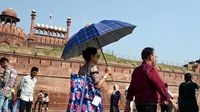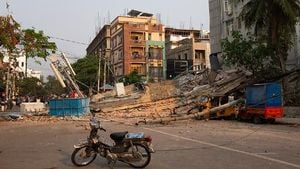Delhi is currently grappling with a heatwave alert, with temperatures projected to climb to 40°C by the end of March 2025, while several southern states, including Karnataka, Kerala, coastal Andhra Pradesh, and coastal Gujarat, gear up for heavy rainfall and thunderstorms. As of March 26, 2025, the temperature in the capital has already hit 33°C at midday, with forecasts indicating a high of 38-40°C later in the day, according to data from AccuWeather’s current weather report for Delhi.
This juxtaposition of scorching heat in the north and impending downpours in the south underscores the diverse weather challenges India faces as it transitions from winter to summer. The India Meteorological Department (IMD) issued the heatwave alert for Delhi on March 17, 2025, cautioning that temperatures could reach 40°C by the month’s end. Typically, March sees maximum temperatures around 30°C in Delhi, making this forecast notably higher than the norm.
The IMD’s Delhi forecast suggests that the heatwave could persist, with temperatures potentially peaking at 40°C by March 31. A heatwave, as defined by the IMD, occurs when the maximum temperature reaches at least 40°C in the plains or 30°C in hilly regions, accompanied by a deviation of 4.5°C to 6.4°C above the normal temperature. In Delhi’s case, temperatures exceeding 35°C in March are considered above average, and hitting 40°C would officially classify the conditions as a heatwave.
This early onset of extreme heat is linked to a combination of climate change and specific weather patterns, as noted in Business Standard’s weather update. The rising temperatures pose significant risks to public health, particularly for vulnerable groups like the elderly, children, and individuals with pre-existing medical conditions. Heat-related illnesses such as heat exhaustion and heatstroke become more prevalent during such periods. Health experts advise staying indoors between 11 am and 4 pm, drinking ample water, and avoiding strenuous physical activity to reduce these risks.
Agriculture, too, faces threats, especially for northern India’s wheat crops. High temperatures can impair grain filling, potentially reducing yields and impacting food security and farmer livelihoods, a concern echoed in Reuters’ report on India’s weather. In stark contrast, southern states are preparing for a different kind of weather event. The IMD has predicted heavy rainfall in Karnataka, Kerala, coastal Andhra Pradesh, and coastal Gujarat, with recent alerts signaling thunderstorms, hail, and moderate to heavy rain.
On March 25, 2025, a nowcast warning for Karnataka highlighted thunderstorms with hail and moderate rain, as detailed in an X post by IMD. The previous day, March 24, coastal Andhra Pradesh received a red warning for heavy rain and severe thunderstorms, per another X post by IMD. These forecasts extend to Kerala and coastal Gujarat, where similar conditions are expected.
The All India Weather Forecast Bulletin for March 26, 2025, reinforces these predictions, noting heavy rainfall at isolated places in Jammu-Kashmir-Ladakh-Gilgit-Baltistan-Muzaffarabad, alongside thunderstorms and lightning in Coastal Karnataka, South Interior Karnataka, Kerala, and Mahe. A cyclonic circulation over the Bay of Bengal appears to be driving this wet weather in the south.
While the rainfall could alleviate heat and support agriculture after dry spells in some areas, it also brings risks of flash floods, waterlogging, and disruptions to transportation and daily life. The IMD recommends that residents remain vigilant, avoid flooded areas, steer clear of downed power lines, secure loose items, follow evacuation orders if necessary, and maintain emergency supplies like food, water, and medications.
These divergent weather patterns illustrate India’s climatic diversity at this time of year. In the north, Delhi and surrounding areas contend with intensifying heat, while the south anticipates significant rainfall. Southern farmers hope the rain will boost crop growth, but excessive precipitation could lead to flooding or soil erosion, damaging harvests. In the north, the heatwave threatens winter-sown crops like wheat, chickpea, and rapeseed, with the IMD warning that above-average temperatures could diminish yields, affecting food production and supply chains.
Delhi authorities have responded to the heatwave alert by urging residents to stay hydrated, avoid direct sunlight during peak hours, and wear light clothing. The government is exploring additional measures, such as establishing cooling centers in public spaces like community halls and libraries to offer respite, particularly for those without air conditioning. Plans are also underway to distribute free water bottles at metro stations and bus stops, while health departments are intensifying campaigns to raise awareness about preventing heat-related illnesses.
Current conditions, with a recorded maximum temperature noted in an X post by IMD, show Delhi’s situation worsening as the month progresses. In the southern states, residents are encouraged to monitor weather updates and take precautions during the anticipated rainfall and thunderstorms. Heavy rain could prompt school closures and traffic delays, prompting emergency services to remain on standby. Rescue teams are prepared to address potential flooding or landslides, ensuring swift responses to any incidents.
March traditionally marks a shift from winter to summer in India, but this year’s weather appears unusually extreme, with elevated temperatures in the north and substantial rainfall in the south. Climate scientists attribute these anomalies to global climate change, which is increasing the frequency and intensity of weather events worldwide. In India, rising temperatures, shifting rainfall patterns, and more pronounced extremes are becoming hallmarks of this shift.
Dr. Rajesh Kumar, a senior meteorologist at the IMD, emphasized, "The early onset of heatwave conditions in Delhi is a clear indication of changing climate patterns. We are seeing more extreme weather events, and it’s crucial for both the government and the public to take proactive measures to adapt to these changes." As Delhi prepares for temperatures reaching 40°C by the end of March 2025 and southern states brace for heavy rainfall, residents across these regions must adapt to their respective challenges.
The capital’s heatwave demands vigilance to protect public health and agriculture, while the south’s rainfall requires readiness for potential disruptions. These contrasting conditions highlight the need for tailored responses to India’s evolving climate, underscoring the broader implications of a warming planet. As the month concludes, the nation watches how these weather events unfold, balancing hope for relief with caution against their risks.







